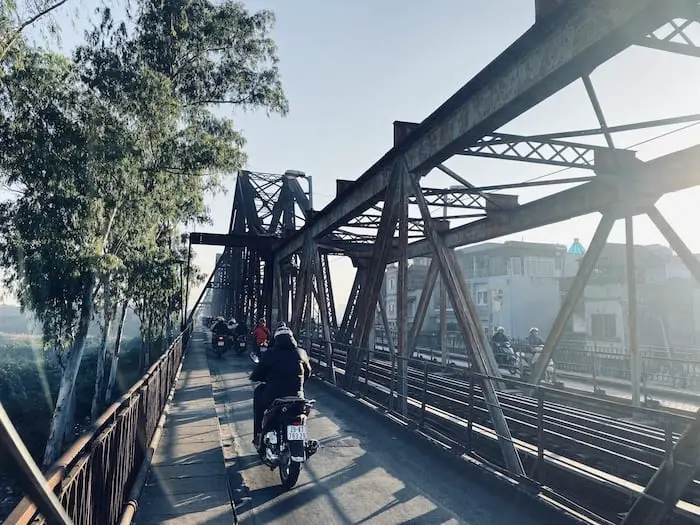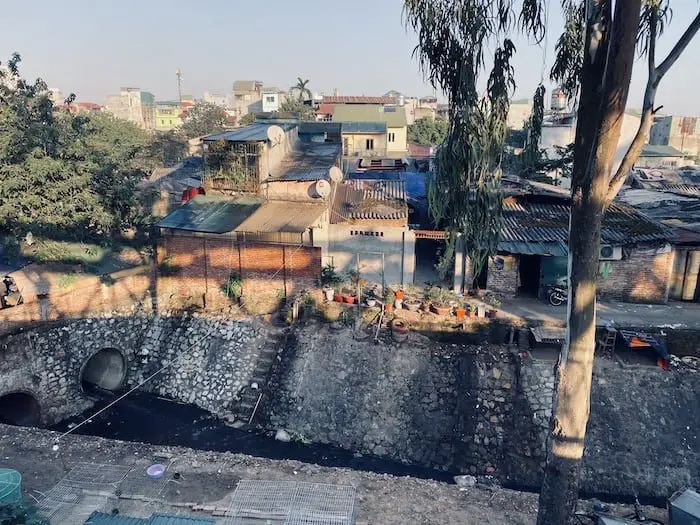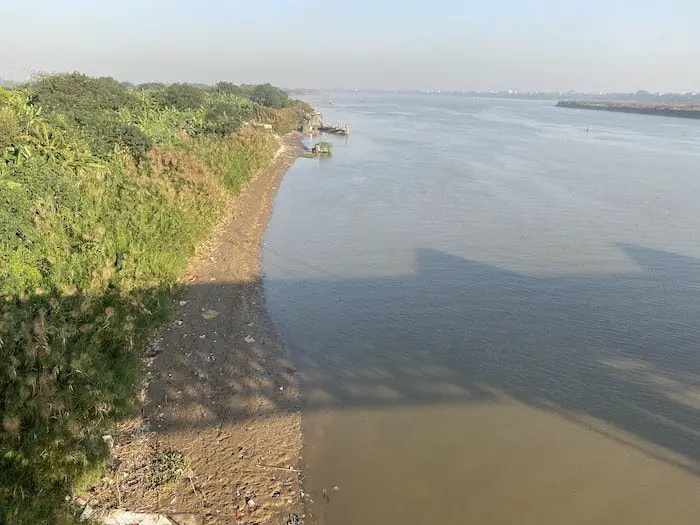The Long Bien bridge is an iconic one located in Hanoi, Vietnam. The bridge is now one of many bridges that cross the Red River from the Long Bien area into Hanoi, Vietnam.
The Long Bien Bridge in Hanoi, Vietnam, is an iconic bridge that was designed by the great French architect Gustave Eiffel. The bridge has a long history and is an important part of French rule in Vietnam. It was a target of bombings by the American forces during the Vietnam War. Today, you can ride a motorcycle or bicycle or walk across the Long Bien Bridge.
Table of Contents
- The Architect Of The Long Bien Bridge Is Gustave Eiffel
- About the Long Bien Bridge
- The Long Bien Bridge Today
- How To Get To Hanoi, Vietnam
- Related Questions
When you visit Hanoi, Vietnam, you will see the Long Bien bridge connecting the downtown part of Hanoi with the district on the other side of the river known as Long Bien. The Long Bien Bridge has an exciting design and history.
Ride with me as I show you some screens from the Long Bien Bridge in Hanoi. I will frequently ride the bridge on my bicycle.
The Architect Of The Long Bien Bridge Is Gustave Eiffel
Gustave Eiffel was a French engineer and architect. He was born in France in 1832 and was a graduate of the prestigious school of Ecole Centrale des Arts et Manufactures.
His most famous work is the Eiffel Tower in Paris, France. The Eiffel Tower was built for the Universal Exposition in Paris in 1889.
Eiffel also contributed to the iconic Statue of Liberty in New York City. But more than that, his work influenced many buildings—structures, monuments, bridges, and viaducts worldwide.
Gustave Eiffel is known to be the architect and designer of this iconic Long Bridge. He designed and created quite a few bridges in Vietnam and throughout Asia.
Besides designing the Long Bien Bridge, Gustave Eiffel also designed other bridges in Vietnam. Some examples are the Ghenh- Bridget and Rach Cat Bridge in Bein Hoa City, Dong Nai Province, and the Truong Tien Bridge in Hue, Vietnam.

The History of the Long Bien Bridge
Gustave Eiffel designed the bridge for the architects Dayde and Pille of Paris. A sign on the old part of the bridge still lists their name.
The bridge was constructed from 1899 to 1902 and completed in 1903. It connected Hanoi’s downtown Hoan Kiem area with Long Bien over the Red River.
During the French rule of Vietnam, it was called the Paul- Doumer Bridge. It was named after Paul Doumer, the then Governor-General of French Indochina.
About Paul Doumer – Governor General of Indochine
Paul Doumer was born of modest means as Joseph Athanase Doumer. His background was in mathematics.
He ruled French Indochina from 1897 to 1902. During this time, the French colonies lost millions of francs each year. He was determined to turn this around, so he levied a burdensome tax on opium, wine, and the salt trade.
The Vietnamese, Cambodians, and Laotians who would or could not pay these heavy taxes would lose their house and land. This forced many of them to become day laborers.
He established French Indochina as a market for French products and French Businessmen. Not caring about the hardship this would cause the Vietnamese, Cambodian, or Laotian populations.
His goal was to outfit Indochina, especially the capital Hanoi, with modern infrastructure as France would have had. Under his rule, several large-scale projects took place, including building the Long Bien Bridge. This is why the Long Bien Bridge was first called the Paul Doumer Bridge.
Doumer returned to France in 1901 and held various top government positions. His last post was in 1931 when he was elected president of the French Republic. He was assassinated in 1932 while attending the opening of a Book Fair in Paris, France.
About the Long Bien Bridge
The Long Bien bridge is 2.5 kilometers or 1.5 miles in length. When it was built, it was the longest bridge in Asia. More than 3,000 Vietnamese helped take part in the construction of the bridge.
Two roadways on the bridge would allow cars to cross in a single file. In the center are train tracks allowing the trains from Haiphong and other areas to enter Hanoi’s central train station.
For the French colonial government, the bridge was of strategic importance. It allowed them access to Haiphong’s seaport and to secure North Vietnam’s control.
In 1954, when the French left Vietnam, Paul Doumer’s name was taken off the bridge, and the bridge was renamed the Long Bien Bridge. For many years it was the only bridge that connected Hanoi to the main port of Haiphong, Vietnam.

The Long Bien Bridge and the Vietnam War
The Long Bien Bridge was heavily bombarded during the Vietnam War. That is why, even today, you can only see some sections of the old French bridge built by Gustave Eiffel; the American forces bombed many areas of the bridge.
During the war, this bridge was of extreme strategic importance as it was the only bridge that connected Hanoi’s capital to the principal seaport of Haiphong. Of course, this would have been essential to allow goods and people to enter the capital city of Hanoi, Vietnam.
The first attack on the bridge came in 1967. The bridge’s center span was attacked by 20 United States Air Force F-106 fighter bombers. The center section of the bridge fell.
This bridge was so well built that CIA reports of the bombing said it did not appear to sustain as much damage as they hoped it would work even with this intense bombing.
Throughout the war, this bridge was always a target of American bombings. They hoped to cut off the supply lines of Hanoi from the port city of Haiphong. We had heard older Hanoians tell us the Americans stopped bombing the bridge when the Vietnamese placed some U.S. Servicemen on the crew to repair the damage by the American bombs.
Whether that was ever the case or not, the Long Bien Bridge was a huge iconic symbol for the Vietnamese during the war with America. There is a lot of wartime poetry and songs about the Long Bien Bridge.
Despite the heavy beating the bridge received during the war, it was only unusable in 1972 when it fell victim to the first coordinated attack using the new laser-guided smart bombs.
Many American service members sent to bomb the Hanoi capital were captured and placed in the famous Vietnamese Hoa Lo Prison in Hanoi. The American servicemen were released from the Hoa Lo Prison in 1972; they boarded white and green camouflaged army buses. The American service members were driven over the Long Bien Bridge to the Gia Lam Airport to return home to the United States.

The Long Bien Bridge Today
Today, the Long Bien Bridge that Gustave Eiffel designed is one of many bridges that link the Hoan Kiem district of Hanoi with Long Bien. Cars are not allowed on the bridge, only motorcycles and bicycles.
Many people will also walk the bridge to take photographs of the Red River and the surrounding areas. Some trains travel down the bridge’s center several times daily to Hanoi’s train station.
Some parts of Gustave Eiffel’s original structure and design remain intact. Other parts clearly show where the bridge sustained intense bombing, so significant gaps in the bridge were filled in and repaired.
There is some talk that the French and Vietnamese Governments are talking about a joint project to restore the Long Bien Bridge to its former appearance. Gustave Eiffel would have been pleased to see the bridge return to its former glory.
The Long Bien Bridge is a must-see when you visit Hanoi, Vietnam. The bridge is steeped in history, and world-class architect and designer Gustave Eiffel also designed it.
How To Get To Hanoi, Vietnam
To glimpse the iconic Long Bien Bridge in Hanoi, Vietnam, you must journey to Hanoi in person. Fortunately, there are numerous ways to reach Hanoi, with flying being the most common choice for travelers. Hanoi boasts international and domestic airports conveniently situated for easy access to the city center.
Suppose you’re seeking travel options to reach Hanoi from virtually anywhere. In that case, I recommend exploring the comprehensive selection of transportation choices available on the BookaWay website, accessible through the link below.
To admire the Long Bien Bridge and immerse yourself in the charm of Hanoi, you’ll need to embark on a journey to this vibrant city.
At A Bus On A Dusty Road, we discuss travel, life, and ex-pat living. We are all about “Living Life As A Global Citizen.” We explore social, cultural, and economic issues and travel.
We would love to have you be part of our community. Sign up for our newsletter to keep up-to-date by clicking here. If you have any questions, you can contact me, Anita, by clicking here.
Listen to our Podcast called Dusty Roads. You can find it on all major podcast platforms. Try out listening to one of our podcasts by clicking here.
Subscribe to our A Bus On A Dusty Road YouTube Channel with great videos and information by clicking here.
Related Questions
Is It Safe To Go Out In the Early Mornings In Hanoi, Vietnam?
It is usually safe to go out early in Hanoi, Vietnam. The streets of the city are always bustling and alive with a lot of activity and excitement. People in the city start their days very early—one of the best things to see in the early morning exercisers. You must also get up early to see the early morning exercise. There are many places in Hanoi where you can see a lot of early-morning exercisers.
To find out more about the early mornings in Hanoi and to see a video about early morning exercise, you can read our blog Early Morning Exercise in Hanoi, Vietnam, What You Need to Know by clicking here.
What Should I Do If I Need Emergency Medical Care In Vietnam?
If you get an illness or injury while traveling in North Vietnam, there are Government (Public) Hospitals, but you may find that the hospital conditions are not up to the western standards of medical care. It would help if you instead considered getting to Hanoi to have a doctor at one of the Expat Medical clinics or hospitals check you out. If the Hanoi clinics or hospitals cannot help you with your medical needs, you may need to go to another Southeast Asian country or go home to get the necessary medical care.
You can find out about getting adequate medical in Hanoi and North Vietnam by reading our blog Guide to Emergency Medical Care in North Vietnam by clicking here.

